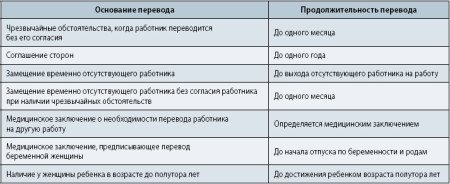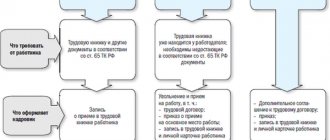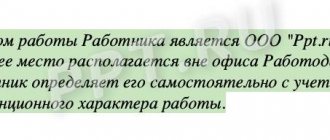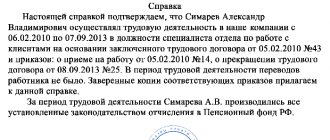Despite the fact that paragraph 1 of Article 72 of the Labor Code of the Russian Federation states: “if, at the end of the transfer period, the employee’s previous job is not provided, and he did not demand its provision and continues to work, the condition of the agreement on the temporary nature of the transfer loses force and the transfer is considered permanent” - It is impossible not to formalize this situation with documents.
If employees who have temporarily received new duties and transferred to other job positions continue to work in them, new additional agreements to employment contracts and orders must be drawn up. That is, you need to arrange a permanent transfer instead of a temporary one.
What is translation according to the Labor Code of the Russian Federation?
In accordance with Article 72.1 of the Labor Code of the Russian Federation: transfer to another job is a permanent or temporary change in the labor function of an employee or the structural unit in which he works (if the unit was specified in the employment contract), without changing the employer, as well as transfer to another job locality together with the employer.
Translation happens:
- Temporary.
- Permanent.
The translation is made according to:
- By agreement of the parties.
- At the initiative of the employee.
- At the initiative of the employer.
Translation is when:
- The employee's job function changes.
- The employee was transferred to another structural unit of the company.
- The employee moves to another location with the employer.
Transfer from a temporary position to a permanent one according to the Labor Code of the Russian Federation
Article 58 of the Labor Code of the Russian Federation presupposes the presence of certain requirements. A fixed-term employment contract may become invalid if neither the employee nor the employer has previously requested termination of the document due to its expired date. At the same time, the specialist continues to perform his functions after the contract has expired.
Attention
After a fixed-term employment contract has expired, it automatically becomes concluded for an indefinite period. Additional agreement will be required. It will indicate that the contract is of unlimited duration, and the work changes in nature from temporary to permanent.
When an employer has the right and when is obliged to issue a temporary transfer
Temporary transfer means a temporary change in a job function or structural unit. During a temporary transfer, the employee retains his previous place of work.
During a temporary transfer, the employee’s job function, that is, responsibilities and position, changes. It is not enough to simply change job responsibilities; the employee must be transferred to another position.
If only the job title of an employee changes, the job responsibilities do not change, and there is no need to formalize this with a transfer. In this case, we can talk about renaming the position. To formalize this, you need to make changes to the staffing table and the employment contract.
More on the topic:
How to temporarily transfer an employee to remote work?
Most often, the transfer occurs at the initiative of the employer. But, the Labor Code of the Russian Federation provides for cases when an employer can transfer an employee without his consent and cases when the employer is obliged to offer the employee a temporary transfer.
| The employer is obliged to offer a temporary transfer | The employer has the right to temporarily transfer an employee without his consent, in the event |
| If an employee due to health reasons needs to be transferred in accordance with a medical report. Art. 73 Labor Code of the Russian Federation | Disasters of a natural or man-made nature, industrial accident, industrial accident, fire, flood, earthquake, epidemic and any exceptional cases threatening the life or normal living conditions of the entire population or part of it. Art. 72.2 Labor Code of the Russian Federation. |
| If the employee’s special right (license, right to drive a vehicle, right to carry a weapon, other special right) has expired or been suspended. Art. Art. 83 Labor Code of the Russian Federation. | Downtime (temporary suspension of work for reasons of economic, technological, technical or organizational nature) Art. 72.2 Labor Code of the Russian Federation. |
| The need to prevent destruction or damage to property and to replace a temporarily absent employee Art. 72.2 Labor Code of the Russian Federation |
The following is not a translation:
- Moving an employee to another workplace without changing the employer.
- Moving to another structural unit located in the same area.
- Work on another mechanism or unit, unless this entails a change in the employment contract.
Step-by-step translation instructions
Previously, the procedure for processing a transfer was already regulated, but it is worth establishing clear step-by-step instructions. It comes down to the following steps:
- The employer makes the decision - he notifies him in advance. As a rule, written notification occurs 2 months before the transfer.
If the employee agrees, he puts his signature as a sign of familiarization and agreement with the terms. At the appointed time, a statement is written.- Afterwards, a draft employment contract is prepared. If the difference is small and generally functional, the employee’s competencies do not change, an additional agreement is drawn up. It has the same force as the contract itself; it reflects individual aspects of the agreement.
- The order discussed earlier is drawn up.
- At the end of the procedure, an appropriate mark is made, an entry in the work book.
By and large, the employee himself takes little part in the translation process. The main set of actions falls on the employer; he prepares and executes the necessary documents.
Registration of temporary transfer
The transfer is formalized by an additional agreement to the employment contract. If the transfer is temporary, the agreement must indicate:
- basis for translation,
- translation deadline,
- new employee responsibilities
- other conditions that differ from those established by the previously signed agreement.
Based on the agreement, a transfer order is issued in the form accepted by the company or in the unified T-5 form approved by Resolution of the State Statistics Committee of the Russian Federation dated January 5, 2004 No. 1.
The employee must be familiarized with the order and signed.
An entry about a temporary transfer is not made in the work book (part 4 of article 66 of the Labor Code of the Russian Federation and clause 4 of the Rules for maintaining and storing work books).
Translation concept
The legislator indicates that transfer means a change in the nature of the job, including the branch/department in which the employee is located. In this case, the employer remains, the movement occurs within the company, and therefore is called internal. We are talking about opening a new representative office, moving the enterprise to another city or subject of the Russian Federation.

The general rule of transfer requires the written consent of the employee; it is drawn up both in the form of an application and in the form of a signature on the notice. At the same time, in practice, an agreement on the official transfer of a citizen is often used. In practice, citizens holding certain positions may go on maternity leave, administrative leave, or be absent for a long time on a certificate of incapacity for work. A temporary person takes over and has the right to internal transfer in the future.
Components of an order
The document has OKUD code 0301004. It is used in accordance with Resolution of the State Statistics Committee of the Russian Federation dated January 5, 2004 No. 1. It is these moments that are reflected in the upper right part of the paper. It must also contain the OKPO form number and the full name of the organization that resorts to drawing up this kind of orders. In addition, the serial number of the document, the name and date of its preparation should be located at the top.

If the transition is permanent, then the second row in the small table of two dates remains empty. When making a temporary transfer, columns “from” and “to” are filled in whenever possible.
No preamble is required; the document immediately implies the completion of an action. The reasons and grounds for issuing the paper will be established after a description of the employee’s old and new positions has been compiled.
The body of the form begins with the word “assign.” If this is T-5, then it usually contains information about:
- surname, name and patronymic of the employee;
- personnel number;
- the term of the transfer (or one date, if irrevocable action is implied);
- the employee’s previous place of work (including the name of the structural unit, if any);
- position, rank, class of work indicating qualifications, category;
- the reason for issuing the order;
- a new position or place of work (in addition to the name of the department and position, the salary planned for accrual and the bonus to it, if any, are indicated).
In the final part, the signatures of both the head of the institution (on whose behalf the order is drawn up) and the employee who is being transferred are placed. No HR signature is required.
If this is form T-5a and we are talking about several persons, then for ease of registration all data is entered into a table. In addition to the above lines, it includes the type (permanent or temporary). Signatures of employees stating that they have read the document and agree are located in the last column.
Who to submit to
If the initiator of changes in working conditions is an employee, he must write an application requesting a transfer from a part-time job to his main place of work and submit it to the employer. The document is written addressed to the head of the organization. The document is accepted by an authorized employee: secretary, office worker or personnel service employee.
To avoid disagreements, when submitting an application, the employee receives confirmation that it has been accepted, for example, the signature of the recipient on a second copy, which remains with the applicant.
Wording in orders and labor
A short statement is made in the order and work book. The name of the new position is indicated here. After this it is indicated:

Date of transfer – day, month and year- Employee's name
- Name of previous position held on a temporary basis
- New position title
- Signature of the head of the personnel department in the work book or the employer in the order
The information in the work book is entered as briefly as possible, since the format does not allow describing the details. The order may additionally indicate details of the employment contract, various information about the person and other information of significance.
The process of transferring from a temporary position to a permanent one is not distinguished by complex mechanisms, stages of collecting documents and signing a number of papers. At the same time, the procedure time is also quite short, but you should pay attention to the terms of the transfer and some subtleties. Any employee must evaluate the advantages and disadvantages; there is no need to rush into making a decision, because it is of enormous importance for him.
Top
Write your question in the form below
Possible problems for the employee
For an employee, translation is always associated with a number of nuances. If the re-registration concerns a change in position from a temporary to a permanent position or a transition from part-time status, then the following problems may arise:
- Violation of the period for calculating annual paid leave in the case when re-registration is carried out through dismissal.
- Making entries in the work book, which may subsequently become a negative factor when calculating length of service for calculating a pension.
- When planning to make large purchase and sale transactions involving borrowed funds, re-registration through dismissal may become grounds for refusal to approve a bank loan.
In the case where the transfer occurs for a person combining several jobs, interruption of work becomes difficult. This will also cause a problem when calculating long-service insurance benefits upon retirement.
Reasons for transfer

When a person is transferred to another position, which will already be permanent for him, then there must be certain conditions and grounds:
- The employee can show himself on the positive side. In this case, he will be promoted and given a slightly higher salary. But if he does not pass the certification commission, then his salary will be reduced, which is due to his appointment to a lower position.
- Enterprises can change their organizational structure. For this reason, workers are transferred from one position, for example, liquidated, to a completely different one.
- An employee is also transferred to a branch of an enterprise, company, as well as to another division by territoriality.
- The staff in the organization may be reduced and positions may also be reduced.
- Vacancies for a certain position appear.
There are also certain conditions if a person is transferred to a position temporarily. And among them, the most important is when a person, the position he occupied, is replaced. In this case, an indefinite period is established. This may include illness, pregnancy, going on vacation and other issues. But it is worth noting that its duration is usually no more than one month. Otherwise, you should draw up the necessary documents and arrange a permanent transfer.










